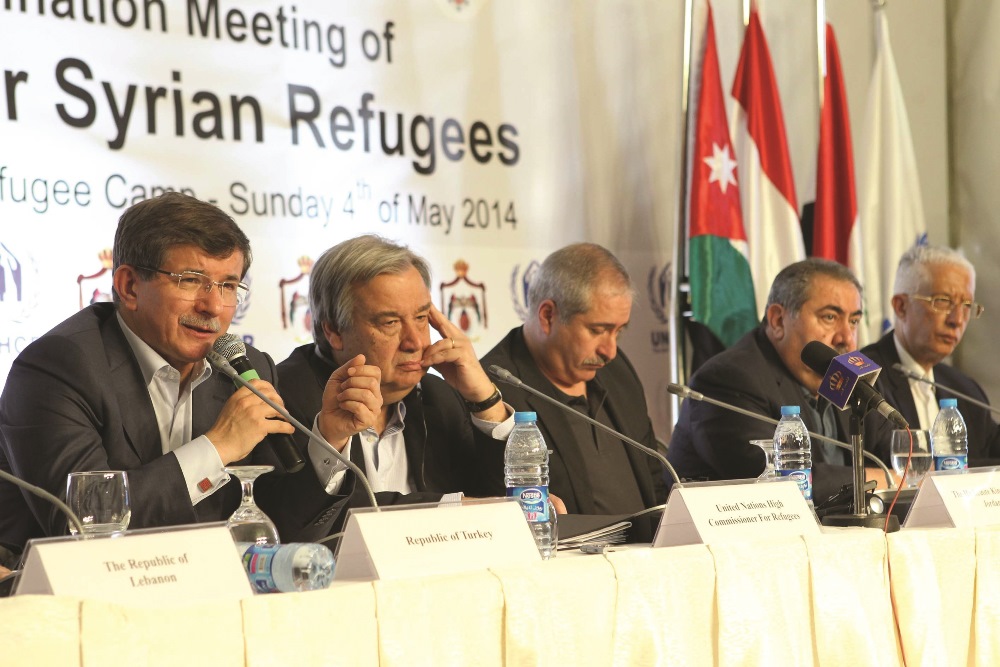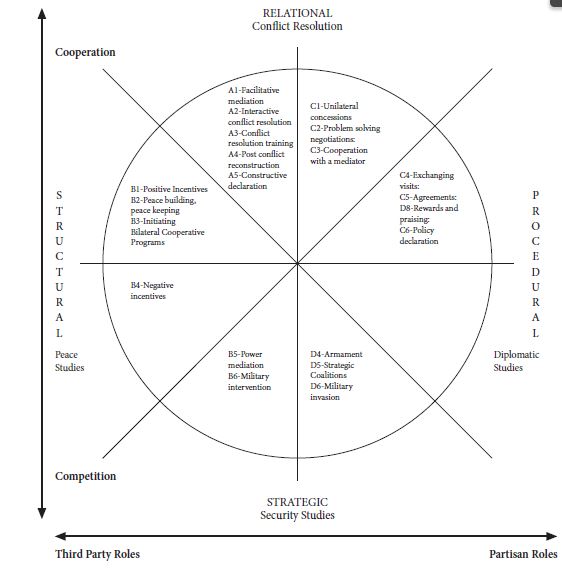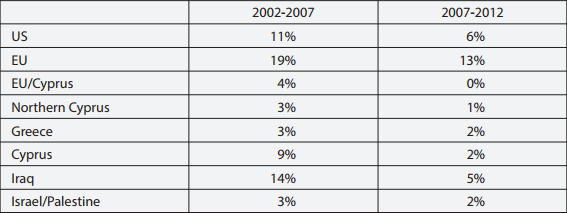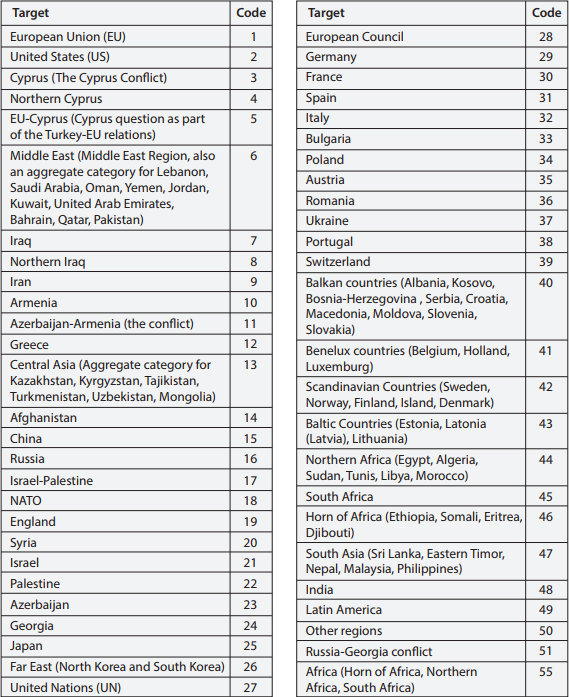Datasets of the behavior of international and intrastate actors reflect a rich tradition. Following the behavioral revolution in political science, scholars interested in capturing patterns of war and armed conflict introduced seminal datasets, e.g., Correlates of War (COW), Uppsala Conflict Data Program UCDP /PRIO and Minorities at Risk (MAR). Event data is another established tool in studying political behavior patterns of international actors. Event data relies primarily on news sources to capture cooperative and competitive actions between and within states. It contains information about dyadic interactions of international actors over a particular time period and consists of coding categories and subcategories. Common in all conflict event datasets is conflict-cooperation as a standard analytical continuum.
These schemas are constructed to depict foreign policy behaviors of the international actors when they are generally direct stakeholders to conflicts. An exception to this observation is “Conflict and Mediation Event Observations (CAMEO),” an event dataset generated to identify third-party mediation in international conflicts.
The CAMEO framework follows the neutral-cooperation-conflict pattern and allows the observation of gradual moves from neutrality to cooperation. It also contains specific subcategories formulated to detect mediation activities e.g., appealing to engage in or accept mediation (028), expressing intent to mediate (039), and mediating (045). That said, the 20 main categories of CAMEO are not organized to differentiate between the two distinct roles, i.e. when the actor is a direct stakeholder in the encounter and when the actor acts as a third-party intervener in other actor’s conflicts. Therefore, in the absence of such analytical refinement, categories (and their sub-categories) such as, “make public statement (1),” “appeal (02),” “express intent to cooperate (3),” “disapprove (11),” “threaten (13),” “exhibit force posture (15),” and “use conventional force (19)” are, unless specified in the subcategories, evaluated in the context of a dyadic relation between the source and the target; that is, when the source is a direct stakeholder in the encounter. The same categories, however, have the potential to describe actions of the source as a third-party intervener in its roles as facilitator, muscle mediator, peacekeeper, peace enforcer, invader, etc. Such fine-tuning is not possible with the abovementioned categories. However, some other categories, such as consult (04), are designed to consist of sub-categories that address both party and partisan roles.
Turkey adopted a balancer role in its region by engaging in various peacemaking activities in the Middle East, the Balkans, the Caucuses, and Africa
In addition to CAMEO, there is an increase in the number of datasets specifically constructed on the role of mediators in interstate and intra-state wars, including: the Civil Wars Mediation (CWM) dataset, International Conflict Management and International Crisis Behaviour (ICB) among others. These datasets are particularly designed to conduct explanatory studies to measure the impact of the third-party intervener on the success of conflict termination. These efforts do not treat third-party intervention roles in the context of the overall foreign policy behavior of international actors.
Recent contributions in the development of even datasets revolve around technical challenges of automated coding and the development of machine-assisted systems. What is missing in this debate, however, is the use of datasets in addressing other important issue areas of international studies, such as debates on bridging the theory-policy gap, foreign policy roles, international interventions, foreign policy restructuring
and middle power/major foreign policy behavior. The current research contributes to the existing knowledge through its extended analytic focus and research goals. More specifically, the FPC is a theory-driven framework. Unlike other data sets, its coding categories have not been generated on an ad hoc basis, but rather are induced from the operational capabilities of different sub-fields of international relations. Therefore, the model provides the means through which the researcher can address important issue areas and explore connections between theory and practice. Similarly, the model enables the analyst to differentiate third-party behaviors and identify their roles in disputes, and makes possible further qualifications on the nature of outside interventions and forms of competitive engagements.
The next section offers a brief overview of Turkish foreign policy practices, lays out the basic features of the FPC-TR dataset, and introduces the codebook of the dataset and data collection procedures.
The AK Party Foreign Policy
In 2002 the AK Party came to power, introducing changes in Turkish foreign policy practices. The leaders formulated such new principles as “zero problems with neighbors”, “proactive multi-dimensional foreign policy in multiple geographies”, and “regional and global responsibility for peace and stability”. Following these principles, Turkey adopted a balancer role in its region by engaging in various peacemaking activities in the Middle East, the Balkans, the Caucuses, and Africa.
These engagements were mostly complementary initiatives with the priorities of the international community in consideration. Beginning in 2009, however, tensions rose between Turkey and its traditional allies. In January 2009, a public disagreement between the Turkish Prime Minister and Simon Perez on a high-level panel at the World Economic Forum in Davos could be considered an early sign of these rising tensions. Another incident took place on May 17th when Turkey and Brazil brokered a nuclear fuel swap deal with Iran, challenging the US plans for a unanimous UN resolution imposing sanctions on Tehran. This was followed by a flotilla crisis between Turkey and Israel, when an international flotilla challenging Israel’s blockade was hit by the Israeli army, killing 10 Turkish activists, in international waters. Further, Turkey and the US have had differences on the crisis in Syria and on relations with Iraq’s central government. Despite the aforementioned incidences, however, there have been considerable positive developments in Turkish-US relations. In April 2009, President Obama paid his first presidential visit to Turkey and called Turkish-US relations a “model partnership.” During the Turkish Prime Minister’s visit to Washington DC in December 2009, the US president highlighted the critical role of Turkey in helping to achieve peace and stability, not only to its neighbors but around the world. In March 2013, US Secretary of State John Kerry selected Turkey as his first official overseas trip.
The aforementioned developments signal different trends in Turkish foreign policy. The current study introduces the FPC model, which intends to capture patterns of foreign policy, by focusing on Turkey’s foreign policy roles, geographical priorities, interaction patterns, and types of foreign policy orientation.
The FPC-TR Data
The FPC is a model that presents 25 foreign policy categories, divided into partisan foreign policy actions (where a party is a direct stakeholder in the dispute) and actions performed by interested outsiders. In either type of action, actors may choose between cooperative and competitive behaviors.10
Figure 1 introduces the FPC model, which integrates foreign policy instruments of decision-makers (partisan or third-party) in a continuum ranging from cooperation to competition.
Figure 1: Foreign Policy Circumplex
Data Collection
With the use of the FPC, two data sets on Turkish foreign policy between 2002-2007 and 2007-2011 were generated. These data sets comprise a chronological account of the actions and intentions of government representatives (the prime minister, the foreign minister and representatives of the executive body) in the first and second terms of the AK Party administrations. The data examines instances wherein Turkey acts as a direct stakeholder and those wherein Turkey performs a third-party role. For this purpose, “verbatim” policy declarations and “factual” reported data on foreign policy actions and intentions were collected, and six major newspapers (liberal and conservative) were screened on a daily basis: Radikal, Zaman, Milliyet, Turkish Daily News, Today’s Zaman, and Vatan. In addition, each entry was doubled-checked with other related web sources containing data on Turkish foreign policy. Data was collected and coded on a sheet by entering: a) the date of the policy declaration; b) the quotation of the action or intention; c) the source of the quotation; d) the code of the FPC category and e) the geographical code concerning the action or intention. The data was transformed and analyzed by means of content analysis.
In the second term of the AK Party government, there was greater cooperation among Turkey’s high priority bilateral relations, such as with the US, the Middle East, Iran, Iraq, Syria, and Russia
Codification
There are three technical decisions that need to be made when conducting content coding: the definition of coding categories, the selection of the recording units, and the system of enumeration. In this study, the 25 categories of the FPC were used and a coding schema to identify targeted countries, geographies, or conflict episodes was also developed.11 Recording units are defined as “all words spoken by a single representative in making a foreign policy statement or declaration, or expressing intention.” As for the codification of regions in cases where two different targeted countries or geographies were found, the recording unit was divided in two and treated as two different statements. In cases where one targeted geography was depicted but more than one intention or action was found, the most dominant final expression was coded. In cases where Turkey adopted a partisan role geographical entry consisted of the “other” actor’s geographical identity. In situations where Turkey acted as a third-party, the number of the country or region under consideration was coded.
 Current Prime Minister Ahmet Davutoğlu (Foreign Minister during that time) speaking at a meeting at northern Jordan’s Zaatari refugee camp, May 4, 2014. AA / Hakan Göktepe
Current Prime Minister Ahmet Davutoğlu (Foreign Minister during that time) speaking at a meeting at northern Jordan’s Zaatari refugee camp, May 4, 2014. AA / Hakan Göktepe
Data Generation and Coding Procedures
Before starting the actual coding process, two graduate assistants were trained in the analytical components of the FPC. At this initial stage, methodological decisions had to be made on critical issues regarding the selection of databases, composition of the data sheet, definition of the recording category, and establishments of coding protocols. This stage was followed by a pilot data generation and codification exercise, and a data collection and codification protocol was subsequently developed.
The two-term data contains a total of 4,673 entries on Turkish foreign policy actions and intentions. As for the first-term data set, the two graduate assistants shared the data equally and conducted analyses. Later, in order to measure inter-coder reliability, each coded year was divided into six two-month periods. Among these phases, three periods per coder were randomly selected. This time, one coder had to analyze average of 350 entries that had originally been coded by the other. The second dataset was formed and analyzed in the same manner.12 The combined inter-coder reliability of the two data sets was 78%.
Findings
The analysis shows that cooperative foreign policy behavior during the second term of the Turkish government is greater than during the first (Table 1). Similarly, Turkey’s engagement as a third party in international conflicts was higher in the 2007-2011 period than in the 2002-2007 period (Table 2).
Table 1: Turkish Foreign Policy Orientation
Table 2: Roles
The data also shows an increase in relational interaction in the second term (Table 3). During the 2007-2011 period, this style was predominantly performed by adopting third-party roles (Table 4).
Table 3: Interaction Styles
Table 4: Relational Interaction
As for coding frequencies, there was a decrease in interaction with the key allies – the US and the EU – during the second term. A similar trend was also observed with respect to key policy issues of special interest for Turkey, such as EU-Cyprus, Cyprus, Greece, and Iraq, and Israel-Palestine (Table 5).
Table 5: Coding Frequencies (Decrease)
Another interesting trend is observed in relation to the geographies with which Turkey increased its interaction from 2007-2012 (Table 6). In particular, there was an increase in relations with North Africa, the Balkan countries, Syria, the Middle East, Armenia, and Israel.
Table 6: Coding Frequencies (Increase)
In the second term of the AK Party government, there was greater cooperation among Turkey’s high priority bilateral relations, such as with the US, the Middle East, Iran, Iraq, Syria, and Russia. With the EU and Israel, however, the reverse was observed (Table 7)
Table 7: Important Bilateral Relations (Cooperation)
High priority relations within the relational and procedural interaction axes are revealing. As presented in Table 8, only with Iran and Syria were the procedural versus relational interaction balances changed in favor of relational interaction in the second term. With Israel, however, a reverse trend was found.
Table 8: Important Bilateral Relations (Relational-Procedural)
As can be seen in Table 9, Turkey’s relations with neighbors generally improved in the second term of the AK party government.
Table 9: Relations with Neighbors (Cooperation)
Between 2007 and 2011, the Turkish government adopted a more cooperative stance in handling international conflicts (Table 10). In dealing with these conflicts, Turkey increased its third-party role, particularly those involving Iran and Syria. With respect to conflicts in Iraq, Iran, and Afghanistan and between Israel/Palestinian and Russia/Georgia, Turkey’s role was similar, albeit decreased (Table 11).
Table 10: Conflict Zones [World] (Cooperation)
Table 11: Conflict Zones [World] (Third Party)
Turkey also increased its relations with the UN and the European Council during the AK Party’s second term, though not with NATO (Table 12).
Table 12: International Organizations (Coding Frequencies)
Conclusion and Contributions of the New Dataset
As demonstrated in the above tables, the analysis shows an increase in foreign policy cooperation during the AK Party’s second term. Similarly, Turkey’s engagement as a third party in international conflicts was higher in the Party’s 2007-2011 term than in its 2002-2007 term. In dealing with international conflicts, Turkey increased its third-party role in Iran and Syria, to a lesser extent in Iraq, Iran, Afghanistan, and in those between Israel/Palestinian and Russia/Georgia. The data also demonstrates an increase in relational interaction during the second term. There was a decrease in interaction with key allies, particularly the US and the EU, as well as key policy issues, such as EU-Cyprus, Cyprus, Greece, Iraq, and Israel-Palestine. That said, there were increased relations with North Africa, the Balkan countries, Syria, the Middle East, Armenia, and Israel, as well as greater cooperation among high priority bilateral relations, such as the US, the Middle East, Iran, Iraq, Syria, and Russia. Finally, relations with the EU and Israel decreased, while relations with the UN and the European Council increased.
The analysis reveals that of the 25 FPC categories, only 3 categories - offering CR training (A3), interactive conflict resolution, (A2) and negative sanctions (B4) - had no corresponding texts in the data studied. This finding is not surprising given that offering CR training and conducting interactive conflict resolution workshops are second-track diplomatic activities and are rarely reported in the daily newspapers. Negative sanctions, however, is an interesting category, as actors who execute negative sanctions often also have the capacity to offer rewards to the same actor. Therefore, this category may be more effective in examining the foreign policy behavior of actors who have the capability of using both rewards and punishments in international affairs. As for theory practice relations, daily practices of liberal understanding of international relations could be materialized with all of techniques listed in the FPC, except those activities that are described in the “strategic” quadrant. The execution of realist theory to international affairs, however, rely on those techniques that are listed in the structural, procedural and strategic quadrants (see, figure 1).
There was a decrease in interaction with key allies, particularly the US and the EU, as well as key policy issues, such as EU-Cyprus, Cyprus, Greece, Iraq, and Israel-Palestine
Another finding is that traditional diplomacy constitutes the backbone of international relations and incorporates all the techniques listed in the structural and procedural quadrants of the FPC. Problem-solving diplomacy, however, involves relational aspects of international relations. The findings suggest that the majority of the coded techniques are procedural in nature, meaning that all the techniques employed to conduct daily affairs, diplomatic routines, and protocols are essential activities in the execution of international relations. Techniques that are listed in the peace studies and diplomatic studies quadrants of the FPC (see, figure 1) demonstrate dual characteristics, as they could be both competitive and cooperative in nature. For example, structural interventions (a third-party role) in the peace studies quadrant could easily be part and parcel of the realist understanding of international relations.
The findings suggest that the FPC has both an analytical and diagnostic value: The FPC captures a wide range of foreign policy behavior and depicts the underlying theoretical and disciplinary foundations of each action in an attempt to reconnect theory and practice of international relations. It could be further used for testing hypotheses, conducting comparative case studies, or in time-series research. At a practical level, the FPC could be employed as a toolbox for foreign policymakers and diplomats. Similarly, it could serve international relations analysts, journalists, and academics as a basis upon which post-hoc analyses of foreign policy behavior can be conducted.
Appendix A: The FPC codebook
Appendix B
Regional categories, high priority relations, international organizations
Regional Categories
Far Regions: (44+45+46+52)+13+47+(26+25+15)+ 49
Africa -general (44+45+46+52)+Central Asia -general 13+South Asia 47+
Far East -general (Far East 26+Japan25+China 15)+Latin America 49
Neighboring Regions: 40 +( 6+8+7+21+22+20+9+14+17)+ (24+10+23)+16+51
Balkan Countries 40+ (Middle East general )+ Caucuses (24+10+23) +Russia-Georgia 51+ Russia16
Close Regions: (43+41+42)
Baltic countries 43+Benelux countries 41 + Scandinavian countries 42
Africa –general: (44+45+46+52)
Horn of Africa 44 + Northern Africa 45 + South Africa 46 + Africa 52
Central Asia –general: (13)
South Asia –general: (47)
Far East –general: (26+25+15)
Far East 26+Japan 25+China 15
Latin America –general: (49)
Benelux –general: (41)
Scandinavia –general: (42)
Balkan –general: (40)
Middle East- general: ( 6+8+7+21+22+20+9+14+17)
Middle East 6+Northern Iraq 8+Iraq 7+Israel 21+Paletsine 22+Syria 20+Iran 9+Afghanistan 14+Israel-Palestine 17
Caucuses: (24+10+23)
Georgia 24+Armenia 10+Azarbaijan 23
Old Europe:
England 19, France 30, Austria 35, Germany 29, Italy 32, Benelux 41
Conflict regions (international):
Cyprus 3, Northern Cyprus 4, Iraq7, Northern Iraq 8, Iran 9, Armenia 10, Azerbaijan-Armenia 11, Afghanistan 14, Israel-Palestine 17, Syria 20, Georgia 24, Russia-Georgia 51
Conflict regions (Turkey):
Cyprus3, EU-Cyprus5, Northern Iraq 8, Armenia 10, Azerbaijan-Armenia 11
High priority relations
Important relations (Turkey)
EU 1, US 2, Northern Cyprus 4, Middle East 6, Iraq 7, Northern Iraq 8, Iran 9, Armenia 10, Greece 12, China15, Russia 16, England 19, Syria 20, Israel 21, Palestine 22, Azerbaijan 23, Georgia 24, Japan 25, France 30, Spain 31, Poland 34, Romania 36, Ukrain37
India 48
International Organizations
NATO 18, UN 27, European Council 28
Endnotes
- For a review and related websites, see: Charles Anderson and John Carter, “Conflict Datasets: A Primer for Academics Policymakers and Practitioner”, Defense and Peace Economics, Vol. 22, No. 1 (2011), pp. 21-42; Philip A. Schrodt, “Precedents, Progress and Prospect in Political Event Data”, unpublished article, Pennsylvania State University, (2012), retrieved May 20, 2013, from http://eventdata.psu.edu/papers.dir/Schrodt.II.38-5.2012.pdf; and International Data Resource Center (IDRC) Foundational Datasets, retrieved May 20, 2013, from http://www.icpsr.umich.edu/icpsrweb/ICPSR/international.jsp#foundational.
- Databases Attributes of Terrorist Events (ITERATE) and the Global Terrorism Database (GTD) are similar methods of studying international terrorism.
- For contemporary event datasets, see Schrodt, “Precedents, Progress and Prospect in Political Event Data.”
- For a detailed discussion, see Tim Veen, “Event Data: A Method for Analyzing Political Behavior in the EU,” paper prepared for delivery at the Fourth Pan-European Conference on EU Politics, Riga, September 25-27, 2008, retrieved May 20, 2013, from www.jhubc.it/ecpr-riga/virtualpaperroom/002.pdf.
- Anderson and Carter, “Conflict Datasets: A Primer for Academics Policymakers and Practitioner”,
pp. 21-42. - See Patrick M. Regan, Richard W. Frank and Aysegul Aydin, “Diplomatic Interventions and Civil War: A New Dataset,” Journal of Peace Research, Vol. 46, No. 1 (January, 2009), pp. 135-146; Bernd Beber, “The Effect of International Mediation on War Settlement: An Instrumental Variables Approach,” New York University Discussion Paper, 2009, retrieved May 20, 2013, from https://files.nyu.edu/bb89/public/files/Beber_MediationIV.pdf; Pelin Eralp, et al., “Delivering Peace: Options for Mediators in African Intra-state Crises,” paper presented at the Conflict Prevention Working Group Meeting, New York University, January 15-16, 2010; Karl DeRouen, Jackob Bercovitch, and Paulina Pospieszna, “Introducing the Civil Wars Mediation (CWM) Dataset,” Journal of Peace Research, Vol. 48, No. 5 (2011), pp. 663-672; Jackob Bercovitch, International Conflict Management 1945-1995: Official Codebook for the International Conflict Management Dataset (Christchurch: University of Canterbury, 1999); Jonathan Wilkenfeld, et al. “Mediating International Crises: Cross-national and Experimental Perspectives,” Journal of Conflict Resolution, Vol. 47, No. 3 (2003), pp. 279-301.
- For a detailed debate, see Stephen M. Walt, “The Relationship Between Theory and Policy in International Relations,” American Review of Political Science, Vol. 8 (2005), pp. 23-48; Glenn Palmer and T. Clifton Morgan, A Theory of Foreign Policy, (Princeton: Princeton University Press, 2006); Jackob Bercovitch, Kevin Clements, and Daniel Druckman, “On Bridging the Gap: The Relevance of Theory to the Practice of Conflict Resolution,” Australian Journal of International Affairs, Vol. 59, No. 2 (2005), pp. 113-140; Joseph S. Nye, “Bridging the Gap between Theory and Practice,” Political Psychology, Vol. 29, No. 4 (2008), pp. 593-603; and Stuart Murray, et al., “The Present and Future of Diplomacy and Diplomatic Studies,” International Studies Review, Vol. 13, No. 4 (2011), pp. 709-728.
- Kalevi J. Holsti, “National Role Conception in the Study of Foreign Policy,” International Studies Quarterly, Vol. 12, No. 3 (1970), pp. 233-309.
- Jerel A.Rosati, Joe D. Hagan, and Martin W. Sampson, Foreign Policy Restructuring: How Governments Respond to Global Challenge (Columbia: The University of South Carolina Press, 1994).
- For a detailed description of the typology and the model, see Nimet Beriker, “Conflict Resolution: The Missing Link between Liberal International Relations Theory and Realistic Practice,” J.D. Sandole, S. Byrne, I. Sandole-Staroste, and J. Senehi (eds.), Handbook of Conflict Analysis and Resolution (New York: Routledge, 2009), pp. 256-271.
- 52 geographical codes were used, including hybrid categories such as regional relations, high priority bilateral relations, conflict prone relations (for Turkey), and conflict zones (for the international community). Operational definitions of geographical codes and conflict episodes are reported in the coding protocol (see Appendix A).
- Data was collected and codified by Sami Cebi, as part of his graduate research project.
* Replication data: Please contact the author: E-Mail address: [email protected]
Acknowledgments: The author would like to thank Dennis Sandole, Fatma Elif Kalan, Funda Özçelik, Ezgi Şeref, Michelle M. H. Şeref, and Onur Şeref for their contributions and comments on earlier versions.
Funding: Part of this research was supported by the Scientific and Technological Research Council of Turkey (TÜBITAK), under contract no. SOBAG-107K460.
















